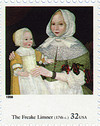
1998 32c Four Centuries of American Art: The Freake Limner
# 3236b - 1998 32c Four Centuries of American Art: The Freake Limner
$2.25 - $3.20
U.S. #3236b
32¢ Mrs. Elizabeth Freake and Baby Mary
Four Centuries of American Art
32¢ Mrs. Elizabeth Freake and Baby Mary
Four Centuries of American Art
Issue Date: August 27, 1998
City: Santa Clara, CA
Quantity: 4,000,000
Printed By: Sennett Security Products
Printing Method: Photogravure
Perforations: 10.2
Color: Multicolored
City: Santa Clara, CA
Quantity: 4,000,000
Printed By: Sennett Security Products
Printing Method: Photogravure
Perforations: 10.2
Color: Multicolored
The term “limner” has been used for hundreds of years. During the Middle Ages, a limner adorned scrolls and manuscripts with elaborate pictures, often in silver or gold. Whatever color was used, there were always six basic types of decorations: animals and humans; branches with leaves or berries; geometric designs; ornamental letters; braids, and scrollwork. In the 1500s, a limner was someone who painted miniatures.
By the 19th century, a limner was an itinerant painter. A skilled craftsman who painted to supplement his income, he would often (as was the case with the Freake Limner) have several canvases painted at one time. These canvases consisted of the entire portrait except for the face. At the time of the sitting, the limner would choose the canvas that best represented the subjects, and add the faces. The name of the artist that was commissioned by the Freake family is unknown.
Mrs. Elizabeth Freake, the wife of a rich Boston merchant and lawyer, and her daughter are featured in this painting. After the first version of the portrait was completed, Mrs. Freake bore a daughter, and the artist painted the child in. The elaborate Dutch lace collar, pearl necklace, and gold embroidery on Mrs. Freake’s red underskirt are all signs of the family’s wealth.
U.S. #3236b
32¢ Mrs. Elizabeth Freake and Baby Mary
Four Centuries of American Art
32¢ Mrs. Elizabeth Freake and Baby Mary
Four Centuries of American Art
Issue Date: August 27, 1998
City: Santa Clara, CA
Quantity: 4,000,000
Printed By: Sennett Security Products
Printing Method: Photogravure
Perforations: 10.2
Color: Multicolored
City: Santa Clara, CA
Quantity: 4,000,000
Printed By: Sennett Security Products
Printing Method: Photogravure
Perforations: 10.2
Color: Multicolored
The term “limner” has been used for hundreds of years. During the Middle Ages, a limner adorned scrolls and manuscripts with elaborate pictures, often in silver or gold. Whatever color was used, there were always six basic types of decorations: animals and humans; branches with leaves or berries; geometric designs; ornamental letters; braids, and scrollwork. In the 1500s, a limner was someone who painted miniatures.
By the 19th century, a limner was an itinerant painter. A skilled craftsman who painted to supplement his income, he would often (as was the case with the Freake Limner) have several canvases painted at one time. These canvases consisted of the entire portrait except for the face. At the time of the sitting, the limner would choose the canvas that best represented the subjects, and add the faces. The name of the artist that was commissioned by the Freake family is unknown.
Mrs. Elizabeth Freake, the wife of a rich Boston merchant and lawyer, and her daughter are featured in this painting. After the first version of the portrait was completed, Mrs. Freake bore a daughter, and the artist painted the child in. The elaborate Dutch lace collar, pearl necklace, and gold embroidery on Mrs. Freake’s red underskirt are all signs of the family’s wealth.










